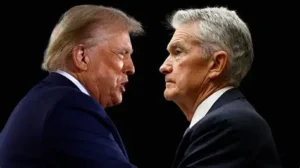Trump, T-Bills, and the Fed:
The Hidden Battle to Curb the U.S. Interest Expense
What do Donald Trump’s efforts to remove Federal Reserve Chair Jerome Powell, new legislation targeting digital stablecoins, and a shift in Treasury debt management have in common? Each plays a surprising role in addressing the skyrocketing interest expense on U.S. government debt—a quiet but potent driver of fiscal pressure and budgetary risk.
The Interest Burden from “The Big Beautiful Bill”
With the passage of Trump’s recent infrastructure and economic package—dubbed the Big Beautiful Bill—federal borrowing surged once again. The cost of that borrowing has become increasingly burdensome.
As near-zero interest era Treasurys from the post-2008 and Covid eras mature, they’re being replaced with fresh notes yielding 4% or more, sharply raising debt-servicing costs. The result? Over $1 trillion in annual interest expense, now outpacing even the U.S. military budget.
This reality has turned debt management into a political and economic battleground.
Trump’s Truth Social Push: Cut Rates, Cut Costs
Former President Trump recently posted on Truth Social, advocating for a multi-point cut in the Fed’s policy rate, which is currently in a 4.25%–4.5% range. His logic: Lowering rates would save the federal government billions in interest on newly issued debt.
While the Fed maintains it doesn’t set rates to manage the Treasury’s balance sheet, Trump’s argument spotlights the tension between monetary independence and fiscal consequences.
“T-Bill and Chill”: A Backdoor Budget Strategy
Strategists at BNP Paribas suggest the Treasury take a “T-bill and chill” approach. By issuing a greater share of short-term T-bills—raising their share from the current 15–20% to 25%—the Treasury could significantly lower its borrowing costs.
Why? Because T-bills yield less than longer-dated notes and bonds. Demand from money market funds and foreign investors—who bought $336 billion worth of T-bills in the past year—remains robust, suggesting that the market could easily absorb the extra supply.
This strategy doesn’t reduce the overall budget deficit, but it does minimize the carrying cost—a win for fiscal stability, at least in the short term.
The Powell-Yellen Tug-of-War
This isn’t the first time short-term debt issuance has stirred controversy. Former Treasury Secretary Janet Yellen faced criticism in 2022 for shifting the issuance mix toward shorter maturities. Ironically, her successor, Scott Bessent, has maintained that same mix without change.
Meanwhile, Jerome Powell has held firm that Treasury financing needs don’t influence Fed decisions. But Trump-aligned voices are pushing for a more coordinated approach.
Former Fed Governor Kevin Warsh, a likely Powell replacement in a Trump administration, recently called for a new Fed-Treasury accord, referencing the post-World War II agreement in 1951 that ended the Fed’s support of low Treasury yields. Warsh suggests that without coordination, policy remains at “cross purposes.”
Is This “Stealth QE”?
Dario Perkins of Global Macro argues that favoring short-term issuance is a form of “stealth QE”—a shadow version of Quantitative Easing. QE typically involves the central bank buying long-term securities to inject liquidity and suppress yields, forcing investors into riskier assets.
While the Fed isn’t actively buying bonds now, the reduction of long-term supply by the Treasury could have a similar effect: suppressing long yields, boosting stock markets, and narrowing credit spreads.
Indeed, the S&P 500 and Nasdaq recently hit new highs, IPOs are heating up, and corporate credit remains cheap. However, for small businesses and consumers, credit remains tight, especially with short-term rates, such as the prime rate, stuck at 7.5%.
Conclusion: A Subtle but Powerful Fiscal Strategy
Trump’s rate-cut crusade, legislative reshaping of digital finance, and the Treasury’s evolving issuance mix all reflect a deeper priority: containing the ballooning interest expense on federal debt.
Whether through overt policy shifts or more subtle maneuvers, such as leaning into T-bills, the fiscal and monetary powers of Washington are being repositioned—not just for economic growth, but also to protect the government’s own bottom line.
The real question: Will these maneuvers be enough to manage the risk, or are they just delaying a reckoning with America’s trillion-dollar interest tab?

